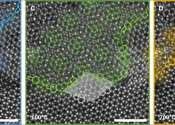Unlocking exotic physics: Exploring graphene's topological bands in super-moiré structures
In a new study, scientists from Singapore and Spain have presented a new avenue for exploring exotic physics in graphene. They focus on electronic interactions in graphene when it is sandwiched in a three-layer structure ...









